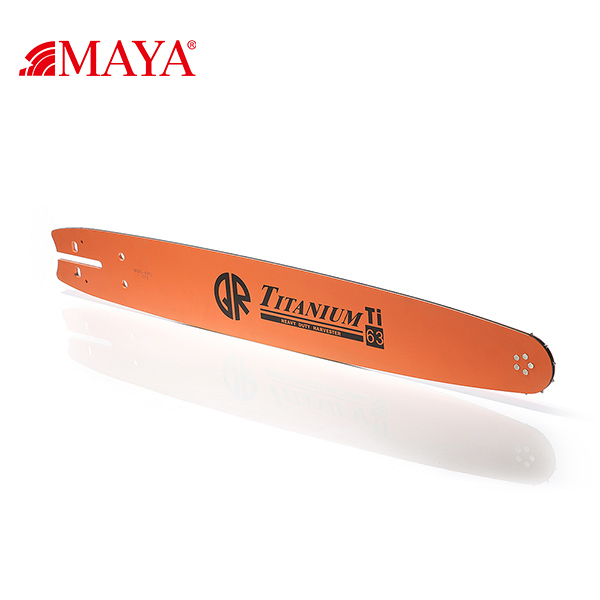Contact Us


News content

Chainsaw Guide Bar Guide
Are you thinking of buying a chainsaw, or have you already chosen a model that suits your needs? If so, now is the time to further familiarise yourself with this tool, which is extremely useful for small and large gardening jobs, DIY tasks and for cutting firewood.
Components of a chainsaw guide bar
As you may already know, the chainsaw guide bar (also called the chainsaw blade) has the vital job of guiding the movement of the chain, which is the machine’s cutting element.
What does a guide bar consist of?
It depends on the model. For example, a carving bar differs slightly from a standard guide bar. Nevertheless, all types share similar characteristics, such as:
Tail: this is the part of the guide bar that fits inside the body of the chainsaw.
Mounting slot: a shaped hole that connects the guide bar to the machine by means of large screws with threaded ends (studs).
Adjuster hole: this houses the pawl needed to adjust the chain tension.
Oil reservoir outlet hole: essential for proper lubrication of the guide bar/chain assembly.
Bar rails: these enclose the groove along the edge of the guide bar.
Groove (or track): the channel between the rails along which the chain runs.
Tip (or nose): this can be reinforced or fitted with a nose sprocket.
Nose sprocket: this can be fixed or replaceable and is a kind of gear wheel that improves the movement of the chain around the bar, reduces friction and helps to tension the chain.
When to replace the guide bar
Guide bar wear is highest in the area where most of the cutting is done. That is normally the underside of the bar: turn the bar over periodically to ensure that it wears evenly on the top and bottom edges.
Burrs form on the bar rails as they wear: these must be filed off, otherwise they cause irregular movement of the chainsaw and premature wear of the chain and the tracks themselves. At the same time, also file both rails level if they are unevenly worn, i.e. of different heights.
It is normal for the depth of the bar groove to gradually decrease during the bar's useful life. In the event of excessive or uneven wear, we recommend replacing the guide bar.
To check whether the guide bar needs changing:
Set the chainsaw down on a flat surface and place your finger on the chain. If it sags then it's time to change the chainsaw blade (always wear chain-resistant gloves when handling the chain).
Press a ruler against the side of the bar and an outside tooth on the chain. If there is still a gap between the bar and the ruler, then the bar is in good condition. If the ruler lays flat against the bar, then the bar is worn and should be replaced.
To extend the bar’s useful life, you can also follow some simple precautions. In particular, when working remember to:
Check the chain tension before and after cutting (to avoid abnormal wear of the groove)
Adjust the flow rate of the lubricating oil according to the type of wood being cut (to prevent the groove from overheating at the points of greatest friction with the drive links)
Regularly and thoroughly sharpen the chain teeth (this reduces abnormal wear of the groove and helps to ensure a clean and precise cut)
Always cut straight and do not push the chainsaw sideways: this is to minimise damage to the groove and avoid warping the bar
Use the chainsaw blade solely for cutting and not as a hammer, lever or wedge for felling trees
Qirui Tools is a professional manufacturer of chainsaw guide bars and chainsaw chains. With decades of experience, products are exported to dozens of countries and regions. Welcome new and old customers to contact us by email, we will provide the best service And the affordable price, thank you.
For more product information links about YouTube, you can click on the link below.
For more product information links about carbide saw chains, you can click on the link below.
More
There are several factors to consider when choosing the right size of chainsaw, so let’s look at each of these in turn now.
Chainsaws are highly versatile tools that allow you to fell trees, prune branches, cut up firewood and even clean up after a serious storm. Many people enjoy using chainsaws, and some people take great pride in owning several models of varying sizes.
Saw chains are used in the cutting process of managing wood, plastics, and metal. Saw chains are made of two interlocked halves that are joined together with rivets or pins. These rivets or pins are typically located at the base of the outer link near the width where it attaches to the saw's arbor. The teeth are located on either side of these pins or rivets. As the chain rotates around the blade, it cuts through materials by pushing them against itself.
The next time you cut wood with a handheld circular saw, be sure to use a carbide saw chain. Carbon steel for this type of chain can be found in nails, springs, ball bearings and old saws. It's especially effective because it doesn't require sharpening after the initial installation. Carbide has excellent resistance to rusting, chipping, bending or deformation.
More
Email: qirui@qiruibar.com
Tel:0086-571-82308666
Add: No. 390, Xiangdafang Industrial Park, Wenyan Street, Xiaoshan District,Hangzhou,Zhejiang,China
Website: www.qiruibar.com



Contact Us
Contact Us
